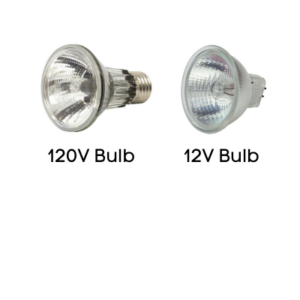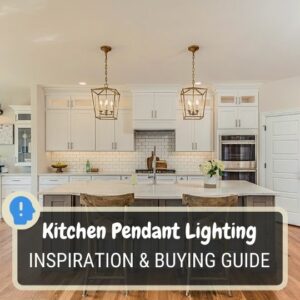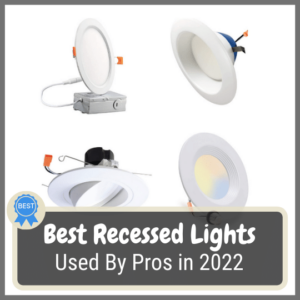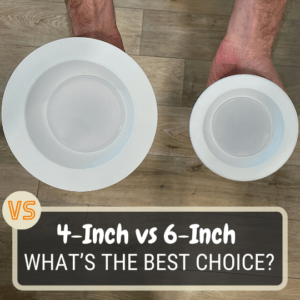
Choosing a light bulb used to be a simple task with only two things to consider; What shape and how many watts? Well, technology in lighting has advanced significantly in recent years and LED has become a whole new category of light source.
In this article, I’ll explain the differences between halogen and LED lighting so that you can make an informed decision when choosing which type of light to use.
What is a Halogen Light vs. LED?
A Halogen light is a type of incandescent light that is filled with halogen gas. The gas prolongs the bulb’s life and allows it’s tungsten filament to burn at a higher temperature than a regular incandescent light bulb. Although halogen bulbs are brighter, they also produce a lot heat!
On the other hand, a LED works completely different. A LED is a semiconductor light that uses a diode to convert electrical energy into light. The diode is made of two different types of semiconductor material, and when an electrical current is applied, the diode emits light. This is where LEDs or light-emitting diodes get their name.
Differences between LED and Halogen Lights
You have probably noticed that there are fewer halogen lights available nowadays. Why? Because of these differences…
Economical
While halogen lights are cheaper to buy, they burn out much faster than LED lights. They also very inefficient. 80 percent of the energy they consume is converted to heat, and only 20 percent is emitted as light.
On the other hand, despite being slightly more expensive, LED light bulbs last longer consume far less electricity. This makes them a much more economical option for overall costs in the LED vs. halogen lighting debate.
Brightness level
Halogen lights emit about 16-24 lumens per watt, whereas LED lights emit about 80-100 lumens per watt. That means that you’ll get a much higher brightness level from LEDs than halogens—even if you use a less-powerful bulb.
For example, a 15-watt LED bulb will be as bright as a 85-watt halogen bulb.
Color Temperature
Color temperature is measured on the kelvin scale (K). Halogen light naturally burns at 3000K, which is slighter “whiter” in color temperature than incandescent bulbs which burn at 2700K.
One of the benefits LEDs is they are available in many color temperatures, ranging from 1800K to 6500K.
Durability
LEDs are generally more durable than halogen bulbs for a few reasons. One reason is they don’t have a filament inside. Filaments are sensitive to vibration and energy surges which can cause them to break.
LED lights are also made of plastic which is much more durable than halogen bulbs which are made of glass that can break if dropped. The glass on a halogen light can also burst if it is hot and gets splashed with cold water.
Energy Efficiency
LED bulbs use up to 85 percent less energy while producing the same amount of light. With energy costs on the rise, halogen lamps are becoming impractical.
In some states, incandescent and halogen lights cannot be sold by retailers because they no longer meet local energy code requirements for efficiency.
Life Expectancy
LED lights last over 25,000 hours, while good-quality halogen bulbs last 3,600 hours. This translates to the expected life of an LED to be more than 15 years, vs 2-3 years for a halogen bulb based on 4 hours of use per day. The extremely long life of LEDs make them especially ideal for use in recessed LED lights in tall or vaulted ceilings where changing a light can be a challenge.
LEDs are also less affected by repeated cycling (on and off) than halogen bulbs which can shorten the life of a halogen lamp.
Risk of Burns
As stated earlier, halogen lights produce a lot of heat. In fact, around 80% of the energy they consume is converted to heat. This creates an increased risk of fire, especially if the wrong lamp is used in a fixture or placed too close to combustible materials.
So, do LED lights give off heat too? Yes, but not much. LEDs only emit 10 to 20 percent of their energy as heat; they’re considerably safer to handle and unlikely to start a fire.
Dimming
LED and halogen lights are both dimmable. That said, halogen lights will usually dim down lower than LED lights will. Using a dimmer switch that is designed for LED lights will ensure you get the maximum available dimming range from them.
Ultraviolet and Infrared Light
Halogen lights emit Ultraviolet radiation (UV) and Infrared light (IR). While halogen lamps have long been the standard for accent lighting and highlighting artwork, they require a quartz or glass filter to prevent the photons from fading the color of fabrics or delicate artwork.
LEDs on the other hand emit almost zero ultraviolet radiation or infrared light.
LED vs. Halogen Comparison Chart
| HALOGEN | LED | |
| Heat production | 80% of total energy | 20% of total energy |
| Brightness per watt | 16-24 lumens | 80-100 lumens |
| Average life expectancy | 3,600 hours | 25,000 hours |
| Average cost | $4/bulb | $6/bulb |
| Energy Usage | 90W | 8W |
| Durable | No | Yes |
| UV & IR emission | Some | None |
| Color Temperature | ~3000K | 1800K-6500K |
| Dimmable | Yes | Yes |
Are LED and Halogen Bulbs Always Interchangeable?
Theoretically, LEDs can replace all halogen bulbs. However, since there are high-voltage and low-voltage halogen light fixtures, you must pay attention to the voltage used. The LED replacement must use the same voltage as the halogen bulb that is being replaced.
If a light fixture uses a low voltage halogen bulb, that means it has a transformer. You need to determine the operating voltage of the transformer and make sure the LED replacement bulb is the same. It is usually either 12V or 24V.
Final Thoughts
There’s obviously a clear winner when it comes to LED vs halogen lighting. LED lights are more energy-efficient, have a longer lifespan, and offer more choices in color temperature. They do cost a little more, but their extremely long lifespan easily offsets the higher upfront cost.
FAQs
What is the difference between LED, incandescent, and halogen lights?
LED, incandescent, and halogen lights differ in how they produce light. LED lights use semiconductor materials to create light, while incandescent and halogen lights use a filament heated by an electric current to produce light. Halogen lights are technically incandescent light bulbs but use a gas to make the filament burn brighter.
Which is brighter – LED or halogen?
LED bulbs are available in various lumen levels, giving you the option to choose one that’s equivalent or brighter than halogen.
Which last longer – CFL or LED?
While I’ve been comparing LED vs. halogen, CFL (Compact Fluorescent Lamps) are another light bulb technology that’s commonly used. Generally speaking, LEDs will last two to three times as long as CFLs.
Should I replace halogens with LEDs?
The simple answer is yes. LEDs will reduce your energy consumption and save you money in the long run.








